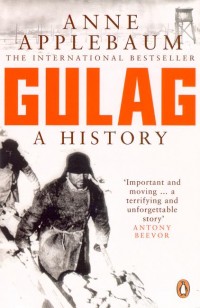25 Points: Gulag
 Gulag
Gulag
by Anne Applebaum
Anchor Books, 2004
736 pages / $18.95 buy from Amazon
1. Roughly speaking, the Gulag was the soviet prison camp system that operated from about 1919 through the late 1950’s, though some camps lasted right up until the collapse of the Soviet Union itself
2. Anne Applebuam, the author of this work, has never been a prisoner in a Gulag. In fact Applebaum is pretty much the total opposite of most people who were in the Gulag system, who were by and large poorer Russians and eastern europeans of various national origins. Applebaum is a member of America’s patrician class. She went to Yale and Oxford, worked as a foreign correspondent for The Economist, and is married to the foreign minister of Poland.
3. I can’t help but wonder if one reason Applebaum decided to tackle such a grim, destitute subject is because, like many people who have a fairly secure, lofty station in life, they are morbidly fascinated by the sheer horror of tragedies beyond their geographic and chronological frame of reference. (note: while I am not a member of said lofty station, I am not currently starving to death and am myself often fascinated by horrific national tragedies)
4. I don’t want you to think that Anne Applebaum simply wrote this book out of some universe of vast privilege and is just sort of casually looking down and and trying to explicate history like the Queen of England talking about what’s happening in Syria with the Prince of Wales at afternoon tea or something. The Gulag system as a topic is so enormous, so horrifically cruel and violent, that she obviously had to submerge herself into it to a degree and for a length of time that most people, let alone most writers of history, would probably find appalling.
5. To be honest, I think her outsider status here works to her advantage more than anything. Most of the Russian language works about the Gulag she cites are very emotionally powerful, but they tend to become monotonous and sort of blend all together in a single,very Slavic voice of total despair. You can only read so many descriptions of old women bitterly weeping while receiving their daily bread ration before it becomes this easily dismissible rhetoric of misery.
6. This book is about 700 pages long. About 110 pages of that length is source notes and bibliographical information of one kind or another. Anne Applebaum offers a tidal wave, like an actual wave that engulfs you, of background information and first hand accounts of what life was like in the Gulag system.
7. While reading it I kept wondering if I would ever have it in me to write a 700 page long book of which 1/7 is pure reference information. I mean, I get that people do that sort of thing for a PHD, but that is presumably a big incentive to finish a book. Did she get some kind of advance for this? Or was this just a kooky little pet project she nursed along for years on her own?
8. This is the single most painful work of non-fiction I have ever read.
9. No, really.
10. If the perpetrators of the Holocaust were, as Hannah Arendt famously wrote, committing the banality of evil, then the Gulag system is about the banality of apathy. At no point was the cruelty of the system or of the administrators of the camps or the guards ever mandated. The purpose of the Gulag was never that of the Nazi camps (even if they do bear horrific similarities), in fact, the actual idea of what this whole prison camp system was for fluctuated a lot over time. Sometimes it was about trying to rehabilitate prisoners, sometimes it was about using their slave labor to turn a profit, sometimes it was just about getting rid of undesirable elements and sending them 10 time zones away in the arctic waste. Though that last thing is literally the only thing it did that actually worked. READ MORE >
October 29th, 2013 / 12:15 pm
